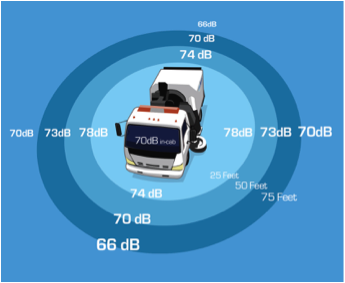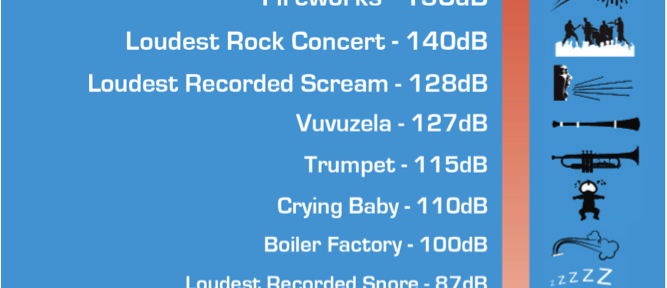Most of us don’t give much consideration to noise on a day-to-day basis, but you may find yourself on a job site in both business and residential areas that limit the decibel level permitted.
Many cities have developed noise ordinances that restrict the allowable noise level(s) at certain times of day for different zoned areas (i.e. residential, commercial, and industrial). Some municipalities even have “Noise Sensitive Areas” identified, such as hospitals, schools, nursing homes, churches, libraries and courthouses. Many list the specific areas and times, or even specified distances required from noise sources in these areas, but many do not identify an exact decibel level allowed and only enforce the ordinance based on complaints.
The maximum allowable noise levels are typically higher during the daytime hours (7am-10pm is common,) but with most sweeping done at night, the sound generated becomes more and more of a factor in your business. We know how to protect ourselves and our employees from exposure to noise but what can we do to reduce the noise we generate so it falls within acceptable levels for affected job sites?
Let’s look at the illustrated chart with some ranges for normal, and not so normal, every-day sounds. Sound ranges are measured in decibels, which in laymen’s terms is the ‘loudness’ of the sound or ‘intensity’ of the sound wave and most commonly used and understood in the industry.
Amazing isn’t it?
Three primary control methods can be utilized to reduce exposure to noise. For sound to even exist, there has to be a source, a path, and a receiver.
Receiver Control – Controlling what reaches the ears of those exposed via earplugs or muffs. On a job site, however, this is not a practical solution. Protecting all people within hearing range would be nearly impossible. But of course, equipment operators should always use hearing protection if exposed to noise levels above 85db for extended periods of time. OSHA regulates this exposure and details the hazards of exposure in OSHA 29 CFR 1910.95, Occupational Noise Exposure, U.S. Department of Labor.
Path Control – Altering the path with sound absorbing barriers. Again, this is not a practical solution for our purposes. Shielding off an entire area would be impossible. Highway construction utilizes this method by building barrier walls between the roadway and residences/businesses.
Source Control – While it is impossible to eliminate all noise generated by your sweeper, there are numerous ways to reduce it. Mufflers, baffles, seals, caulking, shields, sound suppression material, operational RPMs, and even engineering and design of noise generating components can all reduce the amount of noise of your sweeper.
 Based on these three definitions it’s obvious that Source Control is our best option for reducing sweeping noise. Now let’s point out some ways we can implement some of these Source Controls.
Based on these three definitions it’s obvious that Source Control is our best option for reducing sweeping noise. Now let’s point out some ways we can implement some of these Source Controls.
Seals – A simple thing like the integrity of your seals (hopper door seals, fan seal, sweeping deck flaps, intake tube seal, suction and exhaust hoses, etc.) is critical to peak performance and can even allow for operating at a lower RPM in some situations, making this a win/win.
Sweeping head – A properly adjusted sweeping deck to ensure your head is not ‘dragging’ across the pavement can obviously reduce noise. Your sweeping head should be set at a height to ‘glide’ while still maintaining flap contact with the surface.
Sweeping fan – Some sweeper fans or “turbines” are designed to be quieter than others as with the Schwarze Whisperwheel™ fan system. Testing has proven a noise reduction of up to 70% with this design.
Maintenance – Proper routine maintenance on your sweeper and chassis such as brake pads, belts/pulleys, bearings, etc., reduces a considerable amount of noise. Your sweeper will be “purring” through the night.
Sound suppression – Sound absorbing material on a shroud surrounding the power source. Not only are shrouds a great solution for noise reduction, they can also function as advertising billboards for your company name and phone number. Be visible and not audible!
Help your community and put your business in the best light (or sound) by considering the technical and financial feasibility of putting some or all of these Source Controls in place.
By Brenda Bell, Customer Service Manager at Schwarze Industries
Submit your Schwarze Story here: Schwarze Stories

